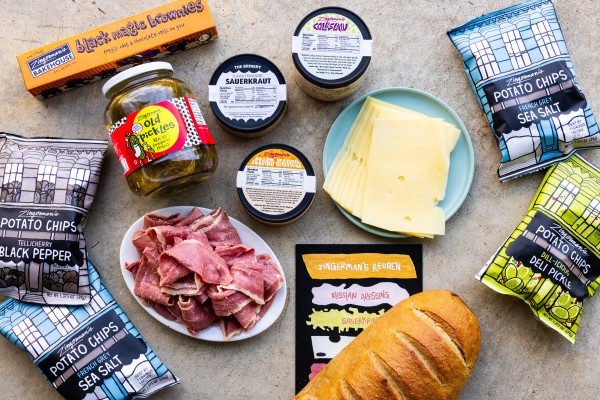Zingerman’s Reuben Kit is full of delicious ingredients for you to make your own Reuben at home! We pack the perishable ingredients in insulated packaging and ship everything with two business day shipping to ensure the kit arrives in great condition. Ideally, you’ll want to assemble and nosh on your sandwiches within a few days to get the full-flavored experience, but some of the accompaniments have a longer shelf life.
Although our seasonal and holiday kits may have added foods or different desserts fitting the occasion, here’s a tour through the basics of what you can expect to find in your kit and how long you can savor their flavors.

Zingerman’s Bakehouse bread
For the crusty, toasty sandwich exterior, you’ll receive Jewish Rye Bread made with freshly milled rye flour and ground caraway seeds or Pumpernickel Bread.
Kits that serve 3-4 include one loaf and kits that serve 6-8 include two loaves. They’re shipped whole so you can slice them when you’d like to assemble your sandwiches.
Keep on the counter to eat within a few days or freeze for up to three months.
The best cured & cooked meats (or tempeh)
Depending on your kit of choice, you’ll stack your sandwich with first cut corned beef, first cut lean pastrami, or oven roasted turkey.
Kits that serve 3-4 include 1 pound of sliced meat and kits that serve 6-8 include 2 pounds.
Keep the meats in the fridge to eat within five days or freeze for up to six months. For the vegetarian reuben with tempeh, cook and eat the tempeh within two to three days.
Flavorful condiments
You’ll get tangy Brinery sauerkraut, sliced Emmentaler Swiss cheese, garlicky pickles, and creamy coleslaw and Russian dressing made in our own kitchen. The vegetarian reuben has sliced cheddar cheese made with vegetarian rennet.
Keep everything in the fridge and plan to use most of these crunchy and creamy toppings, especially the cheese and sauerkraut, within a few days. The Russian dressing and coleslaw are best within a couple weeks.
Zingerman’s potato chips and Zingerman’s Bakehouse brownie bites
To round out the meal, snack on personal-sized bags of Zingerman’s potato chips made by Great Lakes Potato Chip Company and flavored with our custom spice blends.
Kits that serve 3-4 include 4 personal-sized bags and kits that serve 6-8 include 8 personal-sized bags.
For a sweet treat, there are no-nut brownie bites.
Kits that serve 3-4 include 6 brownie bites and kits that serve 6-8 include 12 brownie bites. Eat or freeze the brownie bites within a couple weeks.